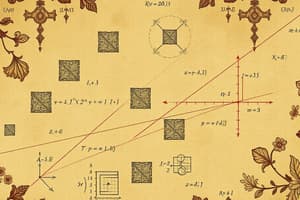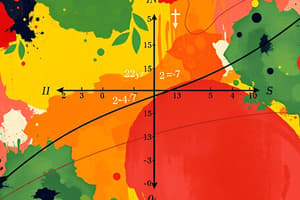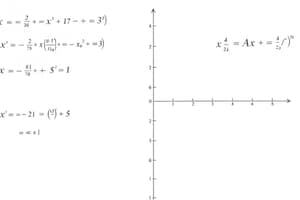Podcast
Questions and Answers
The equation y = mx + b is the general form of a ______ equation.
The equation y = mx + b is the general form of a ______ equation.
linear
What does the 'm' in the equation y = mx represent?
What does the 'm' in the equation y = mx represent?
The slope
When b is equal to 0 in the equation y = mx + b, what does the equation become?
When b is equal to 0 in the equation y = mx + b, what does the equation become?
y = mx
What does the graph of y = mx look like?
What does the graph of y = mx look like?
What is the first step when moving from a graph to a linear equation of the form y = mx?
What is the first step when moving from a graph to a linear equation of the form y = mx?
Why is the equation y = mx used when the graph passes through the origin?
Why is the equation y = mx used when the graph passes through the origin?
In the equation y = mx, what does the letter 'x' represent?
In the equation y = mx, what does the letter 'x' represent?
Flashcards
Linear Equation (y = mx)
Linear Equation (y = mx)
A linear equation in the form y = mx, where 'm' represents the slope.
Slope (m)
Slope (m)
The rate of change of a line, calculated as the rise over run.
Origin
Origin
The point where the x and y axes intersect, with coordinates (0, 0).
Direct Variation
Direct Variation
Signup and view all the flashcards
Moving from Graph to Equation
Moving from Graph to Equation
Signup and view all the flashcards
Step One: Find the slope.
Step One: Find the slope.
Signup and view all the flashcards
Step Two: Use slope and origin.
Step Two: Use slope and origin.
Signup and view all the flashcards
Graphing an Equation
Graphing an Equation
Signup and view all the flashcards
Step One: Create a table.
Step One: Create a table.
Signup and view all the flashcards
Step Two: Plot the points.
Step Two: Plot the points.
Signup and view all the flashcards
Slope Formula
Slope Formula
Signup and view all the flashcards
Example 1: Water usage
Example 1: Water usage
Signup and view all the flashcards
Example 2: Homework completion
Example 2: Homework completion
Signup and view all the flashcards
Example 3: Distance and time
Example 3: Distance and time
Signup and view all the flashcards
Example 4: Baking cookies
Example 4: Baking cookies
Signup and view all the flashcards
Incorrect graph
Incorrect graph
Signup and view all the flashcards
Proportional relationships
Proportional relationships
Signup and view all the flashcards
Linear Relationship
Linear Relationship
Signup and view all the flashcards
Linear Equation Property
Linear Equation Property
Signup and view all the flashcards
Predictive power of linear equations
Predictive power of linear equations
Signup and view all the flashcards
Linear Equation (y = mx + b)
Linear Equation (y = mx + b)
Signup and view all the flashcards
Y-intercept (b)
Y-intercept (b)
Signup and view all the flashcards
Initial Value
Initial Value
Signup and view all the flashcards
Constant in a linear equation
Constant in a linear equation
Signup and view all the flashcards
Slope-intercept form
Slope-intercept form
Signup and view all the flashcards
Slope and direction
Slope and direction
Signup and view all the flashcards
Real-world applications of slope
Real-world applications of slope
Signup and view all the flashcards
Importance of linear equations
Importance of linear equations
Signup and view all the flashcards
Interpreting linear equations
Interpreting linear equations
Signup and view all the flashcards
Study Notes
Linear Equations: y = mx
- A linear equation in the form y = mx represents a straight line that passes through the origin (0,0).
- The variable 'm' in the equation y = mx represents the slope of the line.
- A graph of y = mx will always pass through (0,0)
- The slope 'm' indicates the rate at which 'y' changes with respect to 'x'.
Analyzing Linear Equations
-
The general form of a linear equation is y = mx + b, where 'm' is the slope and 'b' is the y-intercept. (This is a concept that is explained further in the next lesson.)
-
If 'b' equals 0, the equation simplifies to y = mx, indicating that the line passes through the origin.
-
To graph a linear equation of the form y=mx:
- Determine the slope (m)
- Plot the point (0,0).
- Beginning at (0,0), apply the slope (rise/run).
- Draw the straight line passing through this point
-
When you have a graph and want to write the equation you need the slope (m)
Example Problems and Solutions
- Some examples show how to find the slope of a line given two points on the line, and how to substitute the slope into the equation y = mx
- Additional examples demonstrate graphing linear equations in the form y = mx. This involves creating a table of values for 'x' and calculating corresponding 'y' and plotting them on a coordinate plane
How to Move from a Graph to an Equation
- To determine the equation from a graph:
- First find the slope.
- Note that if the line passes through (0,0), the equation will be of the form y = mx, where m is the slope.
- Substitute the slope into the equation y = mx
- Example of How to Find the Equation from Graph Using Slope: In one example a slope of 20 was found by determining the rise over run. The resulting equation is y = 20x
Studying That Suits You
Use AI to generate personalized quizzes and flashcards to suit your learning preferences.




